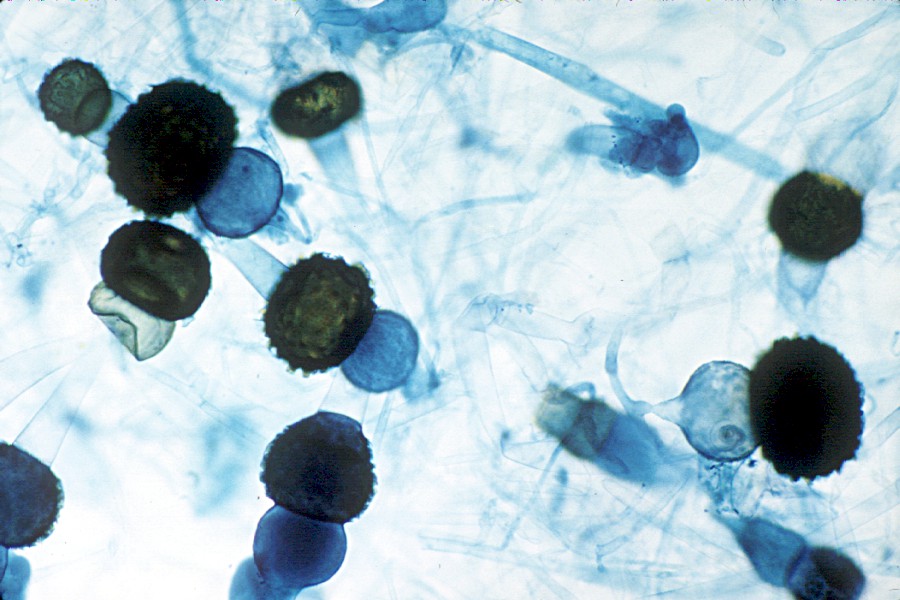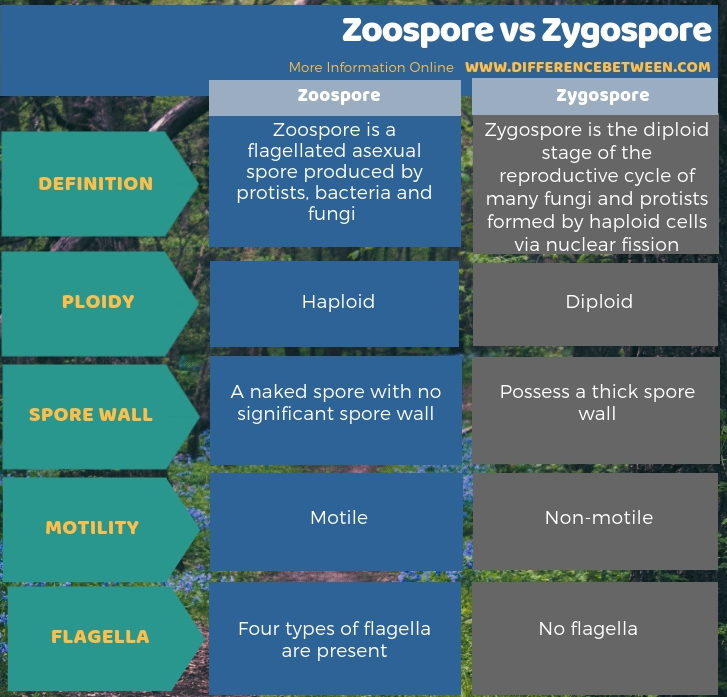The key difference between zoospore and zygospore is that zoospore is a haploid structure while zygospore is a diploid structure.
Zoospores and zygospores are two types of spores produced by the fusion of unicellular gametes. They are reproductive structures. Moreover, both these types of spores originate in the sporangia. However, zoospores are swarm spores with locomotive abilities while zygospores are non-motile.
CONTENTS
1. Overview and Key Difference
2. What is Zoospore
3. What is Zygospore
4. Similarities Between Zoospore and Zygospore
5. Side by Side Comparison – Zoospore vs Zygospore in Tabular Form
6. Summary
What is Zoospore?
Zoospore is a flagellated asexual spore produced by protists, bacteria, and fungi. The flagellum provides motility to the zoospore. The flagellum could be of two different types: tinsel and whiplash. These are present in various combinations. Tinsel flagella possess lateral filaments called mastigonemes. They act as a rudder and provide steering activity to the spore. Whiplash flagellum is straight and helps to propel the zoospore through media.

Figure 01: Zoospore Types
There are four main types of eukaryotic zoospore: opisthokont, anisokont, heterokont, and zoospore with single anterior flagella. Opisthokont is a posterior whiplash flagellum. It is present in the fungal division Chytridiomycota. Anisokont and heterokont are biflagellate zoospores. In anisokont, two whiplash flagella with unequal lengths are present. Heterokont possesses both whiplash and tinsel flagella.
What is Zygospore?
Zygospore is a diploid stage of the reproductive cycle of many fungi and protists. They are formed by haploid cells via nuclear fission. Fungal zygospores mature in the zygosporangia, once specialized budding structures are fused. These structures originate in the mycelia of homothallic fungi or in different mating types of heterothallic fungi and chlamydospores. Specifically, the fungal class zygomycete produces zygospores within their sporangia located at the end of the sporangiophores.

Figure 02: Zygospore
In eukaryotic algae, zygospores develop when the unicellular gametes fuse with each other. These gametes belong to different mating types. Zygospore production is common to many species of Chlorophyta.
Zygospores undergo dormancy due to different environmental factors such as light, heat, moisture, and chemicals secreted by different plants, etc. However, when favorable conditions return, zygospore germination takes place. During zygospore germination, vegetative cells are produced through meiosis.
What are the Similarities Between Zoospore and Zygospore?
- Both zoospore and zygospore are two types of spores.
- They are reproductive structures.
- Also, fungi produce both these structures commonly.
- Additionally, both types of spores originate in the sporangia.
- Moreover, unicellular gametes fuse together to form both types of spores.
What is the Difference Between Zoospore and Zygospore?
Zoospore is a flagellated asexual spore produced by protists, bacteria, and fungi where flagellum provides motility to the zoospore while zygospore is the diploid stage of the reproductive cycle of many fungi and protists formed by haploid cells via nuclear fission. Therefore, this is the key difference between zoospore and zygospore. Furthermore, zoospore is a haploid structure while zygospore is a diploid structure. Therefore, this is another significant difference between zoospore and zygospore.
Moreover, a further difference between zoospore and zygospore is that the zoospore is a naked spore with no significant spore wall, but zygospore possesses a thick spore wall. Importantly, zoospores are motile due to the presence of flagella whereas zygospores are non-motile since no flagella are present in them. So, this is also an important difference between zoospore and zygospore is motility.

Summary – Zoospore vs Zygospore
Spores such as zoospore and zygospore are reproductive structures. Zoospores are asexual spores produced by protists, bacteria, and fungi. Moreover, they possess flagella and are motile spores. In contrast, zygospores are non-motile spores. They are the diploid stage of the reproductive cycle of many fungi and protists. The key difference between zoospore and zygospore is their ploidy level. Zoospores are haploid whilst zygospores are diploid.
Reference:
1. “Zoospore.” Encyclopædia Britannica, Encyclopædia Britannica, Inc., Available here.
2. “Zygospore.” Encyclopædia Britannica, Encyclopædia Britannica, Inc., Available here.
Image Courtesy:
1. “Zoospores types” By Pancrat – Own work (CC BY-SA 3.0) via Commons Wikimedia
2. “Rhizopus zygospores” By Curtis Clark – Own work (CC BY-SA 3.0) via Commons Wikimedia
ncG1vNJzZmivp6x7pbXFn5yrnZ6YsqOx07CcnqZemLyue8OinZ%2Bdopq7pLGMm5ytr5Wau27GzqiqqaeimnqiusNmsbKfn6i9sL7EaA%3D%3D